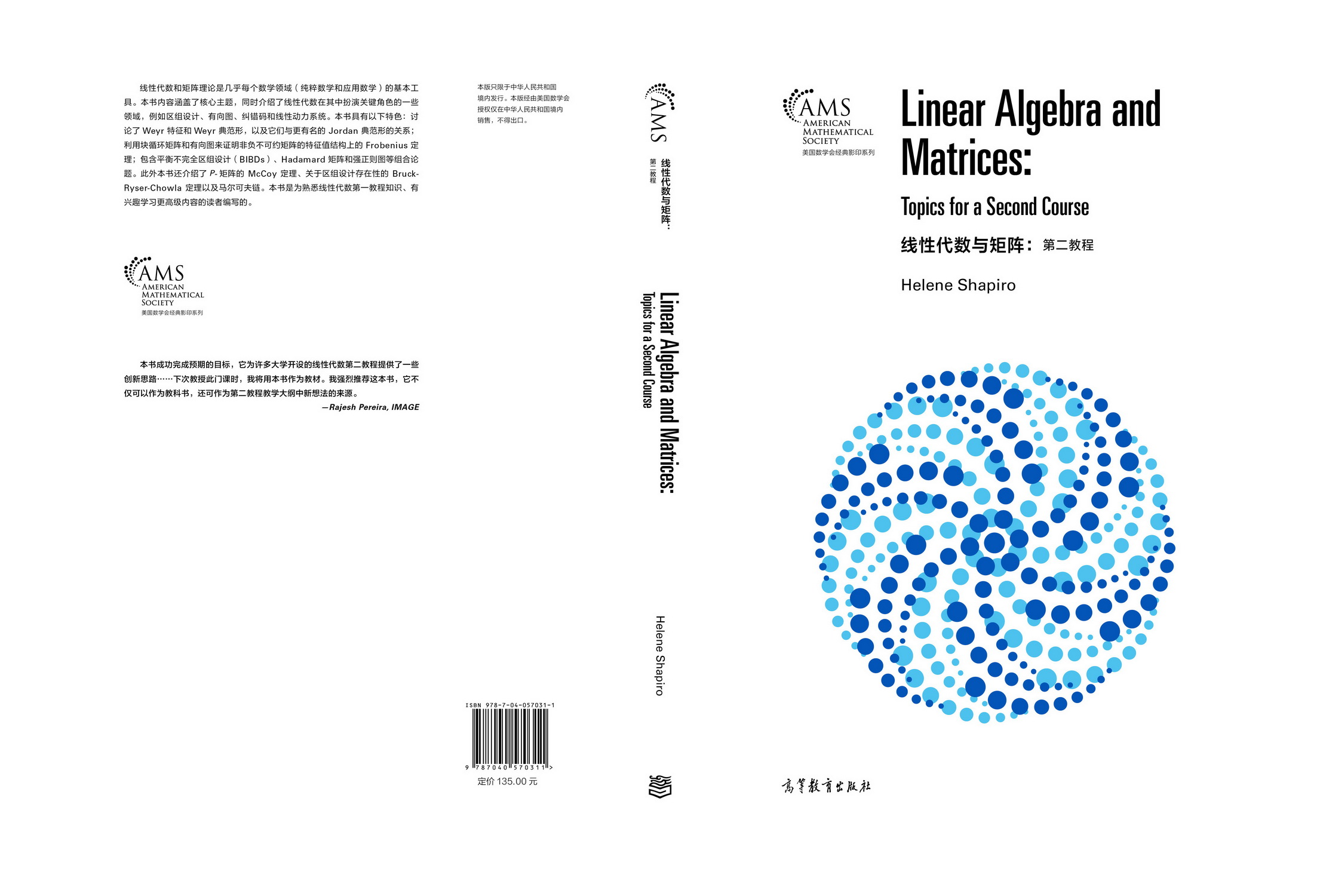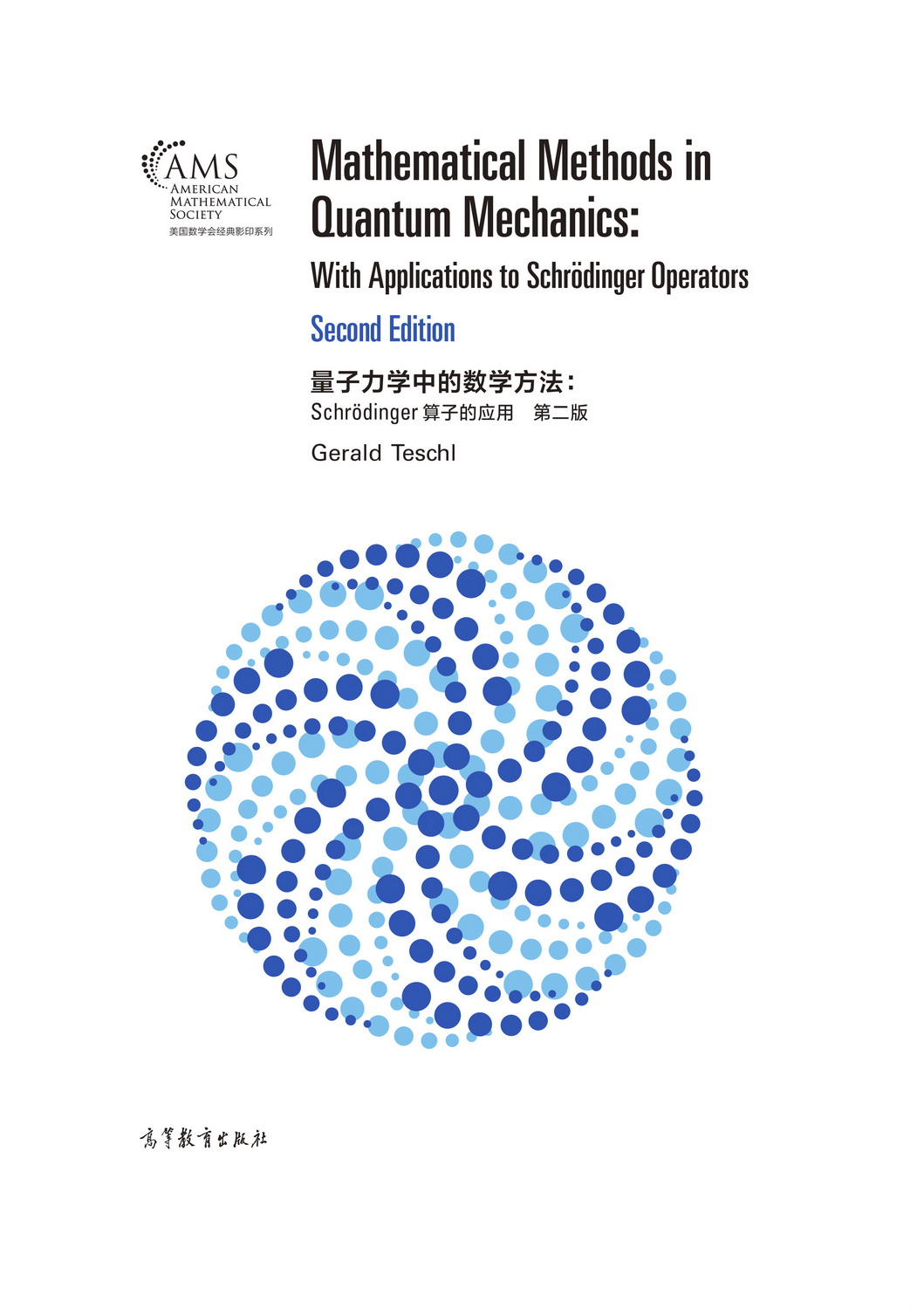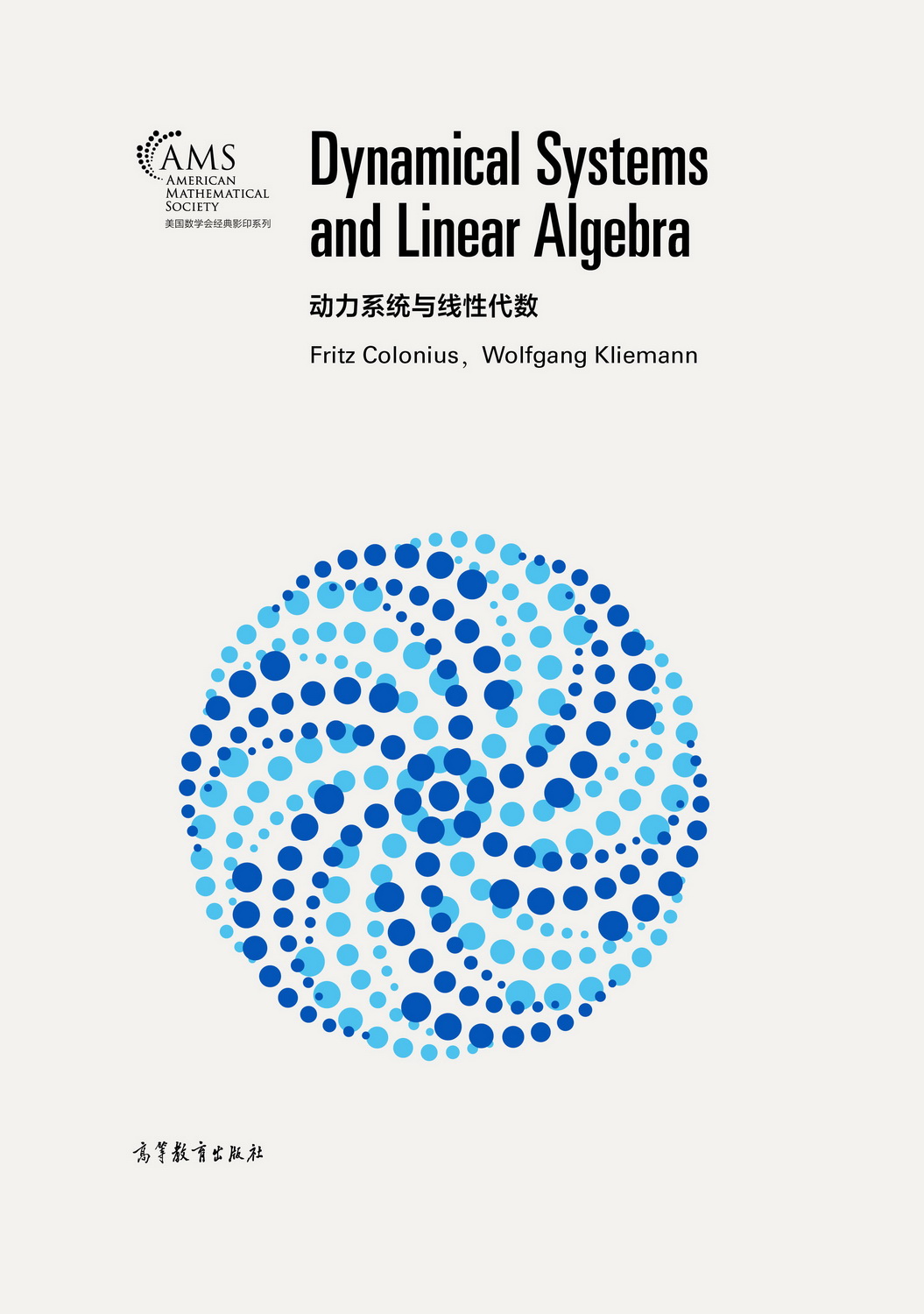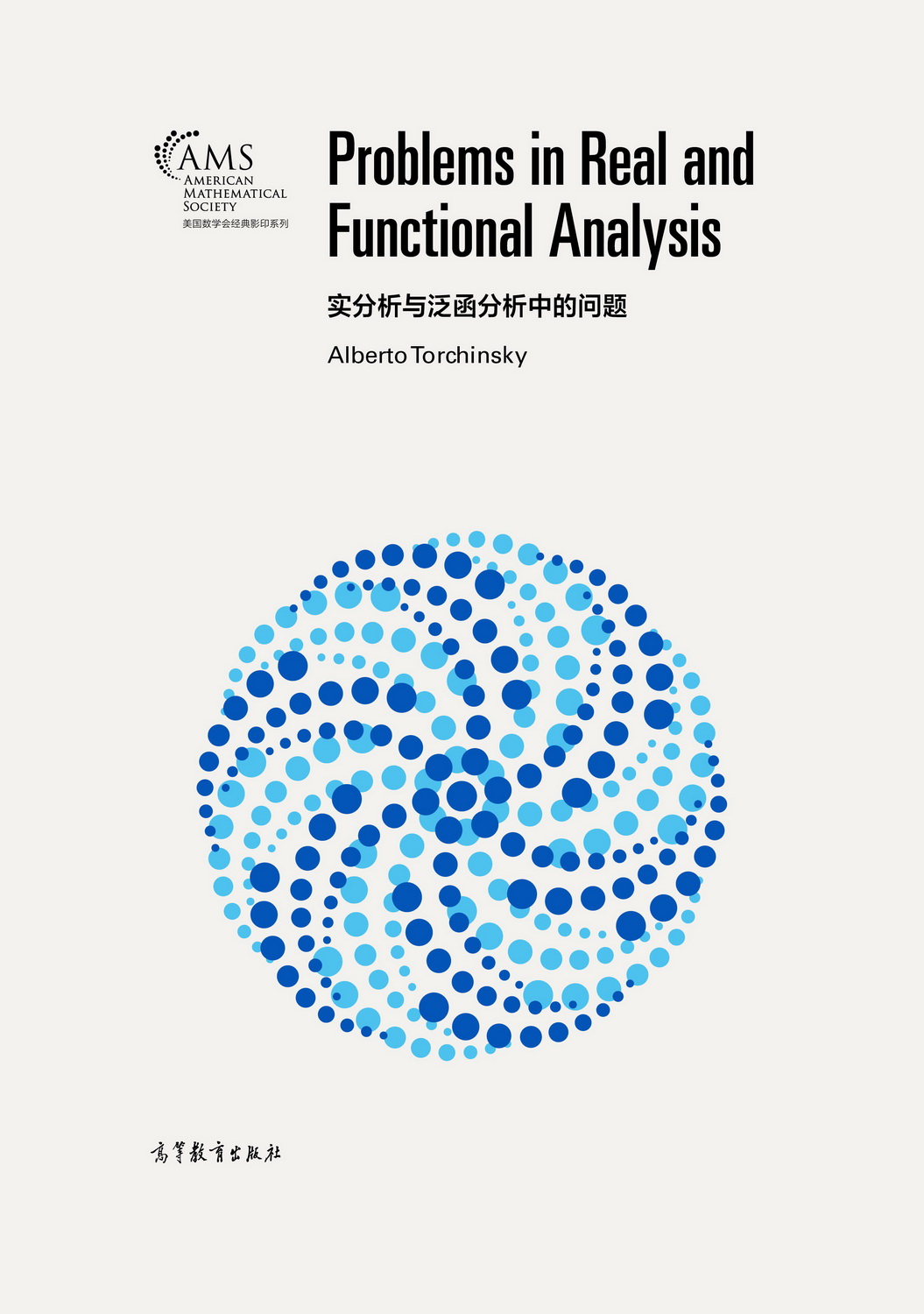线性代数与矩阵:第二教程(影印版)
作者: Helene Shapiro
出版时间:2022-02
出版社:高等教育出版社
- 高等教育出版社
- 9787040570311
- 1版
- 412518
- 48265777-2
- 精装
- 16开
- 2022-02
- 571
- 344
- 理学
- 数学类
- 数学类
- 研究生及以上
前辅文
Chapter 1. Preliminaries
1.1. Vector Spaces
1.2. Bases and Coordinates
1.3. Linear Transformations
1.4. Matrices
1.5. The Matrix of a Linear Transformation
1.6. Change of Basis and Similarity
1.7. Transposes
1.8. Special Types of Matrices
1.9. Submatrices, Partitioned Matrices, and Block Multiplication
1.10. Invariant Subspaces
1.11. Determinants
1.12. Tensor Products
Exercises
Chapter 2. Inner Product Spaces and Orthogonality
2.1. The Inner Product
2.2. Length, Orthogonality, and Projection onto a Line
2.3. Inner Products in Cn
2.4. Orthogonal Complements and Projection onto a Subspace
2.5. Hilbert Spaces and Fourier Series
2.6. Unitary Tranformations
2.7. The Gram–Schmidt Process and QR Factorization
2.8. Linear Functionals and the Dual Space
Exercises
Chapter 3. Eigenvalues, Eigenvectors, Diagonalization, and Triangularization
3.1. Eigenvalues
3.2. Algebraic and Geometric Multiplicity
3.3. Diagonalizability
3.4. A Triangularization Theorem
3.5. The Gerˇsgorin Circle Theorem
3.6. More about the Characteristic Polynomial
3.7. Eigenvalues of AB and BA
Exercises
Chapter 4. The Jordan and Weyr Canonical Forms
4.1. A Theorem of Sylvester and Reduction to Block Diagonal Form
4.2. Nilpotent Matrices
4.3. The Jordan Form of a General Matrix
4.4. The Cayley–Hamilton Theorem and the Minimal Polynomial
4.5. Weyr Normal Form
Exercises
Chapter 5. Unitary Similarity and Normal Matrices
5.1. Unitary Similarity
5.2. Normal Matrices—the Spectral Theorem
5.3. More about Normal Matrices
5.4. Conditions for Unitary Similarity
Exercises
Chapter 6. Hermitian Matrices
6.1. Conjugate Bilinear Forms
6.2. Properties of Hermitian Matrices and Inertia
6.3. The Rayleigh–Ritz Ratio and the Courant–Fischer Theorem
6.4. Cauchy’s Interlacing Theorem and Other Eigenvalue Inequalities
6.5. Positive Definite Matrices
6.6. Simultaneous Row and Column Operations
6.7. Hadamard’s Determinant Inequality
6.8. Polar Factorization and Singular Value Decomposition
Exercises
Chapter 7. Vector and Matrix Norms
7.1. Vector Norms
7.2. Matrix Norms
Exercises
Chapter 8. Some Matrix Factorizations
8.1. Singular Value Decomposition
8.2. Householder Transformations
8.3. Using Householder Transformations to Get Triangular, Hessenberg, and Tridiagonal Forms
8.4. Some Methods for Computing Eigenvalues
8.5. LDU Factorization
Exercises
Chapter 9. Field of Values
9.1. Basic Properties of the Field of Values
9.2. The Field of Values for Two-by-Two Matrices
9.3. Convexity of the Numerical Range
Exercises
Chapter 10. Simultaneous Triangularization
10.1. Invariant Subspaces and Block Triangularization
10.2. Simultaneous Triangularization, Property P, and Commutativity
10.3. Algebras, Ideals, and Nilpotent Ideals
10.4. McCoy’s Theorem
10.5. Property L
Exercises
Chapter 11. Circulant and Block Cycle Matrices
11.1. The J Matrix
11.2. Circulant Matrices
11.3. Block Cycle Matrices
Exercises
Chapter 12. Matrices of Zeros and Ones
12.1. Introduction: Adjacency Matrices and Incidence Matrices
12.2. Basic Facts about (0, 1)-Matrices
12.3. The Minimax Theorem of K¨onig and Egerv´ary
12.4. SDRs, a Theorem of P. Hall, and Permanents
12.5. Doubly Stochastic Matrices and Birkhoff’s Theorem
12.6. A Theorem of Ryser
Exercises
Chapter 13. Block Designs
13.1. t-Designs
13.2. Incidence Matrices for 2-Designs
13.3. Finite Projective Planes
13.4. Quadratic Forms and the Witt Cancellation Theorem
13.5. The Bruck–Ryser–Chowla Theorem
Exercises
Chapter 14. Hadamard Matrices
14.1. Introduction
14.2. The Quadratic Residue Matrix and Paley’s Theorem
14.3. Results of Williamson
14.4. Hadamard Matrices and Block Designs
14.5. A Determinant Inequality, Revisited
Exercises
Chapter 15. Graphs
15.1. Definitions
15.2. Graphs and Matrices
15.3. Walks and Cycles
15.4. Graphs and Eigenvalues
15.5. Strongly Regular Graphs
Exercises
Chapter 16. Directed Graphs
16.1. Definitions
16.2. Irreducibility and Strong Connectivity
16.3. Index of Imprimitivity
16.4. Primitive Graphs
Exercises
Chapter 17. Nonnegative Matrices
17.1. Introduction
17.2. Preliminaries
17.3. Proof of Perron’s Theorem
17.4. Nonnegative Matrices
17.5. Irreducible Matrices
17.6. Primitive and Imprimitive Matrices
Exercises
Chapter 18. Error-Correcting Codes
18.1. Introduction
18.2. The Hamming Code
18.3. Linear Codes: Parity Check and Generator Matrices
18.4. The Hamming Distance
18.5. Perfect Codes and the Generalized Hamming Code
18.6. Decoding
18.7. Codes and Designs
18.8. Hadamard Codes
Exercises
Chapter 19. Linear Dynamical Systems
19.1. Introduction
19.2. A Population Cohort Model
19.3. First-Order, Constant Coefficient, Linear Differential and Difference Equations
19.4. Constant Coefficient, Homogeneous Systems
19.5. Constant Coefficient, Nonhomogeneous Systems; Equilibrium Points
19.6. Nonnegative Systems
19.7. Markov Chains
Exercises
Bibliography
Index










